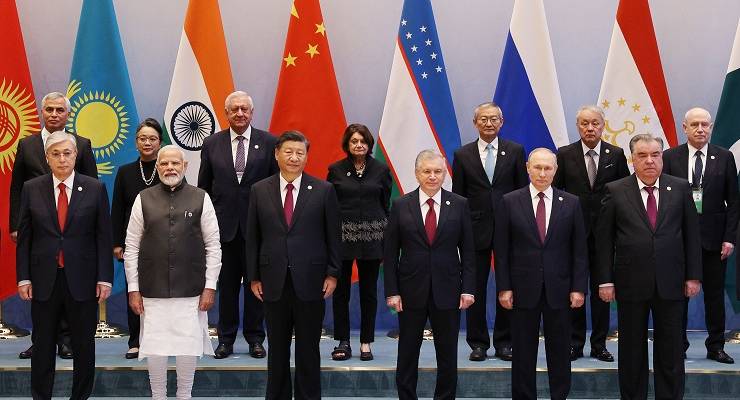
While all the focus on Chinese leader Xi Jinping’s first trip out of the country since the pandemic hit has been on his meeting with Vladimir Putin at the weekend, it’s important not to miss the importance of Central Asia in his swing through a number of its countries.
A combination of Russia’s botched invasion of Ukraine and a number of conflicts that have broken out in on a region right on China’s doorstep means that Beijing sees both opportunity and threat in a region traditionally dominated by Russia, rich with resources but redolent with the advancing threat of radical Islam.
The centrepiece of Xi’s swing through Central Asia was the annual summit of the 20-year-old Shanghai Cooperation Organisation (SCO) in the Uzbekistan capital Samarkand, where he met separately with Putin as well as Indian Prime Minister Narendra Modi.
“It’s a key piece of international architecture that has been crafted by China and until now largely ignored by the Western media,” Geoff Raby, former Australian ambassador to China, told Crikey. He added that China has been slowly building a “parallel” international architecture while still participating in the Bretton Woods international agencies and the United Nations.
Other examples of China-led organisations are the Asian Investment Infrastructure Bank (Australia is a member) and its overarching foreign policy play, the Belt and Road Initiative (BRI).
Central Asia is often colloquially known as “the Stans” (a Persian suffix that means “land of”), and consists of a jumble of nations once part of the mighty Soviet Union. By far the largest of these by geographic size and military importance is Kazakhstan, which has a population of 19 million and is the sixth largest country by land mass in the world. Uzbekistan is the most populous with 35 million people, and the group is rounded out by Tajikistan (10 million), Kyrgyzstan (7 million) and Turkmenistan (6 million). Islam is the main religion in the region.
The SCO was formed in 2001, a successor to the 1996 Shanghai Five. Initially Uzbekistan was added to the group that included China, Russia, Kazakhstan, Kyrgyzstan and Tajikistan. It is now up to nine, with India and Pakistan added in recent years, and Iran gaining full membership at last year’s meeting. There are “observer states” such as Afghanistan, Belarus and Mongolia seeking full membership, others like Egypt, Qatar and Saudi Arabia that have applied to become observer states, and a growing list of dialogue partners and those wanting to be, including Myanmar and the UAE.
“By signing the document for full membership of the SCO, now Iran has entered a new stage of various economic, commercial, transit and energy cooperation,” Iran’s Foreign Minister Hossein Amir Abdollahian said.
A key reason for its founding was the threat of Islamic fundamentalism creeping from the Middle East, Afghanistan and Pakistan through Central Asia into China and Russia but more recently it has extended into extensive joint military and humanitarian aid exercises, as well as combating drug and arms trafficking. Its primary objectives remain domestic security for its members, which helps explain India’s membership alongside its membership of the Quad with Australia, the US and Japan. Raby said the binding force of the SCO was effectively anti-Western democracy.
Beijing is also paranoid about “colour revolutions” occurring on its doorstep, another reason for increasing its support on all levels for the Central Asia and SCO countries, and Xi raised the issue at last week’s summit. The collapse of the Soviet Union — and trying to avoid the same thing occurring in China — remains a central theme in all Beijing’s domestic policy in Xinjiang and foreign policy.
China’s other fundamental reason for creating the SCO was the BRI. The project was originally based on the concept of a new Silk Road that connected China to the Middle East and Europe; in exchange for its economic and strategic support, China extracts certain concessions from its SCO partners.
“In exchange for security and economic support, Beijing has expected SCO members in Central Asia to comply ‘unconditionally’ with requests to transfer wanted individuals across borders, engage in paramilitary co-operation including joint patrols with the People’s Armed Police, and turn a blind eye to oppression in Xinjiang,” a primer on the SCO by the Australian Strategic Policy Institute said.
In terms of China’s security Kazakhstan, Uzbekistan and Kyrgyzstan — and Pakistan, Afghanistan and India — all border the troubled Chinese province of Xinjiang where ethnic peoples from all three countries have been caught up in Beijing’s horrendous program of incarceration, forced sterilisation and family separation as part of its cultural genocide program. Some have suggested that one of China’s key objectives with the group is to ameliorate and remove objections to its program in Xinjiang and to date this appears to have been largely successful, despite all Central Asian countries having significant Turkic ethnic populations similar to the Uyghurs.
Central Asian countries retain borders drawn up by the Soviet Union during the 1924-1936 period, without taking into account economic, geographical and ethnic realities, and many of the borders are hazy and remain disputed.
Many countries have bilaterally settled some or all of their border disputes in recent decades, yet decades-long disputes continue largely because the disputed areas are important in terms of geographical, transportation and water resources management.
One of the most contested regions in Central Asian is water-rich Bakten, on the borders of Tajikistan, Kyrgyzstan and Uzbekistan where 500,000 people live. This is where deadly border clashes between Tajikistan and Kyrgyzstan saw at least 100 people killed between September 14-16 in fighting involving the use of tanks, aviation and rocket artillery. While both sides are trying to resolve the conflict, urged on by Moscow — which has military bases in both countries — and Beijing, the two sides have a bloody history stretching back decades, with more than 230 incidents in past 20 years.
It’s precisely the type of conflict that China wants to avoid as it ramps up its plans for rail routes through the region into Europe and the Middle East to reduce risk of any conflict in the Pacific that could play havoc with traditional sea-shipping routes for imports and exports.
As the eyes of the West — its media and many sleepy governments, such as the one in Canberra — are opened to the realities of what’s at play in Central Asia, it’s clear that Taiwan is far from Beijing’s only concern and priority.








The usual anti Chinese and anti Russian bias on view here. Typical of Sainsbury who seems to have a deep antipathy to all the West’s named enemies. Not much about our neighbourhood gets a look in. Indonesia anyone? Real extermination of a culture going on in West Papua? But nah! Let’s angst about the Uyghurs. Check out the Duran on YouTube and Alexander Mercouris for a much more nuanced overview than this!
Er, no, Tashkent is the capital of Uzbekistan, not Samarkand.
Interesting. A bit more on what actually happened at the summit would be good. My understanding from some of the articles I have read is that Xi effectively guaranteed Kazakstan’s independence and territorial integrity in a bilateral meeting. This may even extend to the other Stans. This could only be seen as either a snub or a warning to Russia which sees itself as the central asian hegemon. There are significant numbers of ethnic Russians living in Kazakstan, and apparently a certain nervousness about Russian intentions.
This is the first time I have seen “the West” pay attention to the SCO which is strange given that it accounts for 40% of the world population, and more than 30% of global GDP but obviously the Golden Billion feel threatened these days.
I doubt there is much to worry about from Russia. In January this year Kazakhstan requested military assistance from Russia (under the CSTO) to control Riots in Kazakhstan.This was provided and the Russian troops dutifully left when no longer required. Most likely this is a signal to the West to stay out of Kazakh matters. Think of the SCO as the Non-Western G9+. Many items were on the agenda including establishing alternative payment mechanisms (as the West unilaterally weaponises SWIFT), trade and moving away from the US Dollar and Euro (also weaponises by the West.
As Western “managed” organisations become less relevant to non-Western nations, these nations are increasingly looking to the SCO and BRICS. As a result there are nations, interestingly including Turkey, that are lining up to join the SCO (along with BRICS). Iran should be a member within a year, Belarus has also applied and it looks like most of the ME nation’s are looking to join.
What is missed is that Kazakhs, Uzbeks etc. not only have antipathy towards both Russia and China but are culturally Turkic/Muslim, and nowadays (prefer to be) economically closer to Turkey (with similar language).
Presently there are ongoing and recently flaring border skirmishes going on between Kyrgyzstan and Tajikistan, Russia has been interrupting Kazakh oil exports, while Russia’s ally Armenia has been at war again with Turkey’s ally Azerbaijan, another Turkic Republic.
On the Belt and Road Initiative, simply look at a map and it appears now that China can/has cut out the spur railway line up to Moscow favouring a focus upon the direct route through Central Asian Republics to its significant markets in the EU; China knows which side its bread is buttered on ….
maybe Central Asia is where the ” friendship without limits” of Russia and China might run into a rough patch.
Now becoming ‘friendship with limitations’ of Putin’s own making…..